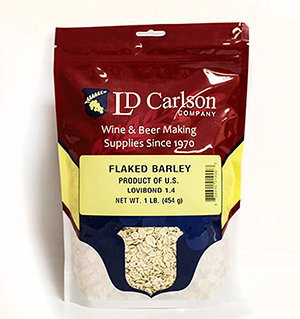Flaked Barley: A Grain of Thought for a Heady Beer
Posted by Matteo Lahm on 7th Jul 2023
Hello, fellow beer enthusiasts! Today, we're diving deep into the world of flaked barley, a hidden gem in the beer-making process. If you're looking to add a unique twist to your home brew, flaked barley might just be the secret ingredient you've been searching for.
So, why would you use flaked barley in your beer? The answer lies in its unique properties. Flaked barley is a raw, unmalted grain that adds a distinct, grainy flavor to your beer. It also contributes to the body and head retention of your brew, making it a popular choice for many beer styles.
Now, you might be wondering, which beer styles are best suited for flaked barley? Well, flaked barley is a versatile ingredient that can be used in a variety of beer styles. It's particularly popular in stouts and porters, where its robust flavor profile shines through. The grainy, slightly nutty flavor of flaked barley complements the rich, dark flavors of these beer styles perfectly
But that's not all. Flaked barley can also be used in lighter beer styles, such as pale ales and IPAs. In these beers, flaked barley adds a subtle complexity to the flavor profile, without overpowering the hoppy character of the beer
However, there are some beer styles where flaked barley should not be used. Lagers, for instance, are known for their clean, crisp flavors. The grainy flavor of flaked barley can interfere with this, resulting in a beer that's less than ideal. Similarly, wheat beers, which are known for their light, fruity flavors, may not benefit from the addition of flaked barley.
So, how can you incorporate flaked barley into your home brew? It's simple. Just add the flaked barley to your mash, just like you would with any other grain. Remember, flaked barley is a raw grain, so it doesn't need to be malted before use.
When it comes to quantities, the amount of flaked barley you use can vary depending on the style of beer you're brewing and the effect you're aiming for. As a general rule of thumb, flaked barley typically makes up about 10-20% of the total grain bill. For a 5-gallon batch of beer, this equates to around 1 to 2 pounds of flaked barley.
If you're brewing a stout or porter and want to emphasize the grainy, robust flavor of the flaked barley, you might want to lean towards the higher end of this range. On the other hand, if you're brewing a lighter beer like a pale ale or IPA and want a more subtle flavor contribution, you might want to use less.
Now, when should you add the flaked barley to your mash? Flaked barley should be added at the beginning of the mashing process. This is because flaked barley needs to be in contact with hot water for a sufficient amount of time to fully gelatinize and release its starches.
To do this, simply mix the flaked barley in with your other grains before adding your hot water. The temperature of your mash should be around 150-155°F (65-68°C) to ensure optimal starch conversion.
Remember, flaked barley is not malted, so it doesn't contribute any enzymes for starch conversion. This means you'll need to ensure you have enough malted grains in your mash to provide these enzymes.
In conclusion, using flaked barley in your home brew requires a bit of planning and precision, but the unique flavor and texture it brings to your beer makes it well worth the effort.
In conclusion, flaked barley is a versatile, flavorful ingredient that can add wonderful subtlety and mouthfeel. Whether you're brewing a robust stout or a hoppy IPA, flaked barley can add a unique twist to your beer. So why not give it a try in your next brew? You might just discover your new favorite ingredient.


